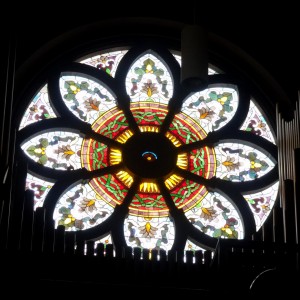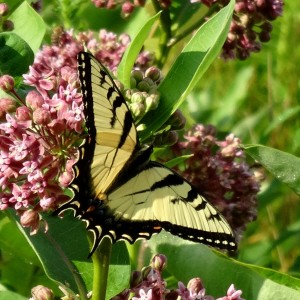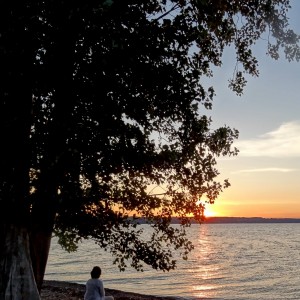 I stood in a small room with high ceilings. A shiny cloth covered lumps on a tall table. On a wooden bench next to me, Mommy lay on her belly, hiding her face in her arms. I watched the up and down waves of her back and heard little gasping sounds. She felt far away. I didn’t touch her or call her name. Instead, I watched rays of bright rainbow light coming from high above. Light fell on wooden benches, on Mommy’s heaving back and on my little arms and hands. The air shimmered with light. I turned my face up to receive it.
I stood in a small room with high ceilings. A shiny cloth covered lumps on a tall table. On a wooden bench next to me, Mommy lay on her belly, hiding her face in her arms. I watched the up and down waves of her back and heard little gasping sounds. She felt far away. I didn’t touch her or call her name. Instead, I watched rays of bright rainbow light coming from high above. Light fell on wooden benches, on Mommy’s heaving back and on my little arms and hands. The air shimmered with light. I turned my face up to receive it.
As a child, I had no name for my experience and didn’t need one. I trusted that light.

As an adult, I pieced together facts about this first memory. I was in the chapel of St. Anthony’s Hospital in St. Louis, Missouri where my father was a patient. My dad was in that hospital in 1948 and was expected to die of a kidney disease he’d had since he came home from World War II. Sunlight streamed through stained glass windows from above. Holy statues are draped at Lent, so it was March 1948. I was under three.
How could I remember such a vivid image at that young age when I remember little else until I was five? In 1948, my mother’s despair threatened my safe world. The light felt bigger and stronger than the threat. It didn’t have a name and wasn’t an idea. It was an image and feeling, an experience of benevolent protection. It wasn’t religious, but it was sacred, and it stayed with me. Even in the hardest moments during my husband Vic’s illness and after his death, I trusted that light. I trusted I would find a way to be all right. If I kept looking, I’d find peace or love or beauty or something strong enough to hold me. 
As a girl, I searched for sacred experience in church, but found it at summer camp when we sat outside on bleachers during evening songs and watched a sunset. I felt it in the vastness of the Grand Canyon as a five year old. I felt glimpses of it in meditation, when I sat with spiritual teachers, and when I birthed my children. And I felt it as I stood next to the vast silence and mystery of death with Vic.
Like my mother, something in me wanted to hide, but instead I turned toward the darkness. Yes, there was grief and suffering, but if I looked, there was something more. I looked every day, sometimes every minute, for the beauty of a butterfly, a wildflower, a friend’s smile, or the peace of a heart-opening poem.
When I looked–and I made it a practice to look–I found reminders of the sacred protection I’d felt in that chapel. When I remembered that light, I was safe.
***
I spoke about this experience in the chapel with more detail in my TEDx talk. What makes you feel safe when you’re frightened or alone? Do you find solace in nature or poetry? I hope you’ll enjoy these related posts: A Survival Guide for Life after Loss: Ten Ways to Nurture the Spirit or A Survival Guide for Life after Loss: Ten Ways to Nurture Your Soul.
I like being alone, and I am fortunate enough to usually feel safe when I am.
When I feel afraid, I turn to the poets and to the Psalms. And I confide in my husband and/or a few intimate friends. I pray. Sometimes just Anne Lamott’s “Help!”
Your thought of an early light-filled memory has helped me this morning to write my own blog post. Thank you!
I always liked being alone–especially when Vic would return in a day or a month. I’ve learned a new way of being alone since his death, and I still miss being with my best friend. Fortunately, I’m not afraid. I love Anne Lamott’s prayers and hear myself inwardly reciting the 23rd Psalm when someone dies. I always turn to poetry.
I’m struggling to keep all the balls in the air these days, but look forward to reading your blog this afternoon or tonight.
When I’m alone and scared I turn on lights. As many lights as I can. I have flashlights in every room in the house and in the car. I keep nightlights on. I light candles. It also helps to have pets around because I have to be brave for these small ones and in the process of trying to be brave for them, I forget to be afraid.
You have a plan, Robin. I’m not afraid of the dark in the outer world (noises, the night, being alone) and feel fortunate about that. But grief, the inner darkness, sometimes brought a sense of hopelessness or despair. It’s good to have an antidote for whatever hard thing we face, and that can be a memory of a safe moment in life. I’m glad you have your animal buddies and your plenty of batteries. I have batteries, too.
How wonderful that you have used your 3-year-old memory to reflect upon the light that eventually brought you hope. You and Shirley have both made reference to the Psalms. I’ll add one: “Lord, lift up the light of thy countenance upon us.” Psalm 4:6
Your posts are always uplifting. Even when the topic is not about light, they shimmer.
Again, Happy Birthday!
Thank you, Marian. My blog didn’t go out this week because we’re still fine-tuning the new website, but you found it anyway. I was ready, but the program that sends out the blog didn’t cooperate. It may go out tonight, but the computer folks seem to have a handle on it. Thank you for those birthday wishes.
I didn’t have strong religious training as a child, but went to a small Presbyterian Church with my grandmother who played the piano and sang hymns. She was a powerhouse and I inherited her prayer book. I gave it to my daughter-in-law (daughter of a Presbyterian minister) on her wedding day. I always looked for that mystical light–I believe because of the intuition of that first memory. I knew there was something more. Thanks for your lovely complement about my work. Grief work is hard, but oh so human.
Thank you for sharing such a poignant and beautiful post.
I’m not religious, but I do believe in a higher power, a divine creative intelligence–I guess it’s all just different terminology. I find my church in nature, and in myself when I am truly in the present moment. Writing haiku, for me, is like a meditation session as well. It forces me to slow down, to really look at what’s going on around me, to find beauty, joy, and appreciation in the most simple of things. And, I call on angels whenever I am struggling with anything, especially archangel Michael.
My light usually comes to me as a feeling–a rush of goosebumps. When this happens, I know my divine guides are near. It is very, very comforting.
Thank you, Gisele. Your terminology suits me well. I’ve had lots of spiritual training as an adult in meditation and philosophic studies and I’ve had the chance to learn from powerful teachers from many traditions. I don’t belong to one religion or tradition, but learn from wisdom where I find it. I’ve found my spiritual home in nature for many years, especially since my husband’s death. It’s a wonderful thing you know just where you find soul support. I love your perspective and look forward to reading more of your haiku.
Thank you, Elaine. There is wisdom and beauty in all religions and traditions. I think this is one of the reasons I don’t want to label myself. I’m quite happy being a student always ready to learn something new. 🙂
Me, too. My first teacher who I met in 1967 had the idea that we should stay open in this way. Even though I love the Dalai Lama, I’m not an initiated Buddhist. It feels right this way.
Elaine, thanks for another beautiful post. I am reminded of the line from one of Leonard Cohen’s songs about not minding a crack because “that’s how the light gets in.” Sometimes I think it’s through the suffering in my life that I’ve eventually been led toward the light, though it’s been a long struggle.
Hi Lynne–I end my TEDx talk with that idea in a Rumi poem. “The wound is the place where the light enters you.” Ring the bell that still can ring,forget your perfect offering… Yes, a long struggle with plenty of hard lessons. Thanks for writing.
What a beautiful and profound post, Elaine. I always feel soothed by your words, but this post (and even the comments) was especially soothing. Your photos weave in and out of the narrative perfectly 🙂
Thanks, Patti. I recently was accepted to be a regular contributor to Open to Hope, but they don’t include photos in their articles. Oh, no. I’ve sent an email asking if I can include photos. Their website certainly seems up to it, and I love bouncing and weaving with images, just as you do. Hope all is well in your gypsy world.
Once again, thanks again dear Elaine, for inspiring writing.
Thank you, Peggy. I feel so lovingly supported by you.
Hope and inspiration abound here on your pages. I too can remember vividly, poignant things when I was barely three, so I understand what you mean about remembering at such a young age. As for solace, I dive into books with inspiration. 🙂
Thanks, Debby. I so appreciate your kind words of support. You have early memories, too. Trauma and uncertainty do that. Thanks for being the informative book person you are, and thanks for taking time to comment.
Thank you Elaine! It’s always inspiring to come here to your page in anticipation of what new inspirational article you have to share. 🙂
Thanks, Debby.
I feel safest when I am quiet and centered. If I get too busy or over committed out there in that world beyond the walls of my home, I feel shaky. So I try to balance doing and being. Your words are incredibly soothing, Elaine. Thank you.
Thanks for your comments and your encouraging words, Mary. I have the same experience of needing quiet and, at this moment, the balance between inner and outer tips toward extroverted. I have to find a way to be OK with busy and not let it rattle me. I’ll also spend more time with new people, sometimes many of them, in coming months. When I start feeling unsafe, it helps if I pause, say Vic’s name inwardly, and focus on my heart. Just a minute of that centers me and helps me remember what matters. When we do these small things often, they become little rituals we can count on.
Elaine,
In your post you asked “How could I remember such a vivid image at that young age when I remember little else until I was five?”
Having specific childhood memories are characteristic of what is now called Type I trauma, which was first described by L. Terr in 1991. It was a key moment and not an overall developmental stage. See Terr, L. (1991). Childhood trauma: An outline and overview. American Journal of Psychiatry, 148, 10-20.
Here is a link to a short summary of the differences between Types I and II trauma
http://childhoodtraumarecovery.com/2014/03/23/childhood-trauma-symptoms-type-i-and-type-ii/
“It was an image and feeling, an experience of benevolent protection. It wasn’t religious, but it was sacred, and it stayed with me.”
One of the characteristics of deep trauma that causes symptoms of PTSD is a total wrecking of one’s world view, such as loss of faith in God by those who are believers. My question is how to help people who have lost that sense of benevolent protection or who never had it regain it or acquire it.
In books I have read about treating symptoms of PTSD this issue is identified as a symptom but it is the only one that is not addressed in treatments. I appreciate your post because you have helped me articulate what it is that would be considered spiritual healing for survivors of trauma with these symptoms.
Thank you.
Thanks for your illuminating comment, John. I’m glad to differentiate these two childhood traumas. I was traumatized by my father’s long illness with many memories of my mother’s despair. People did not know in the 1950s that it would have been best to give the children a simple explanation for the sense of doom and tragedy in the house.
When my husband was ill and dying, I found myself grieving for my father as well. There were many traumas in my husband’s illness and after his death I was diagnosed with PTSD. I didn’t do anything with that diagnosis, but it helped a little to have a name. Throughout his illness, I kept trying to look for and hold on to positive images or feelings, to remember I was loved and would still be loved. After my husband’s death, nature kept me glued together and got me out of my mental loop for short periods–until I needed another walk. My kind doctor said he felt many of his patients who were caregivers were deeply traumatized by the suffering and medical treatment they witnessed. In every situation, I could find the opposite of that darkness and fear–kind friends who brought food and quiet silence as family and close friends awaited death in the hospital, the kindness of a resident’s tears as she tried to make my husband comfortable, the sunny June morning with birds singing when my son and I left the hospital the morning after my husband’s death. There was always something to balance the darkness. I still make it a practice to look for “the opposite.” It serves me well. I tell people about this simple practice in bereavement settings and write about it in my upcoming book.
Thank you for writing and letting me know, Elaine
Your beautiful writing always touches my heart and soothes my soul. Thank you for that, dear Elaine ♥
Thank you, Marty. I appreciate your support and your dear loving heart. Your kind guidance helps so many people find a way.
Such a beautiful post… that higher power is with us, always. Where we find peace and comfort when we need it the most….
Thank you, Ann. Sometimes we’re so busy looking into the darkness that we forget to search for the Light within it. It’s always there.